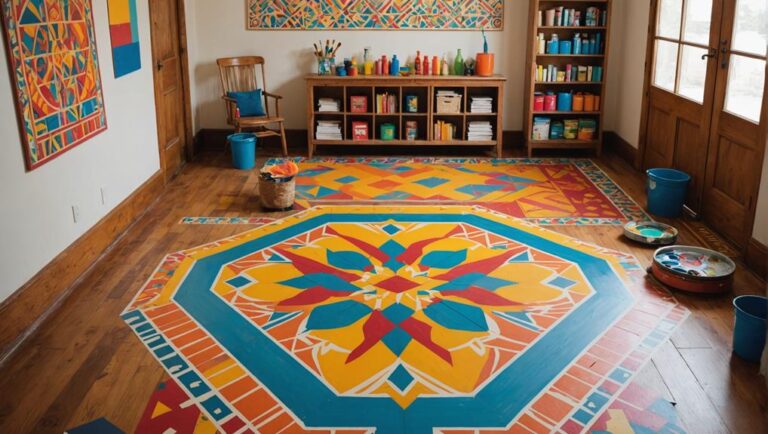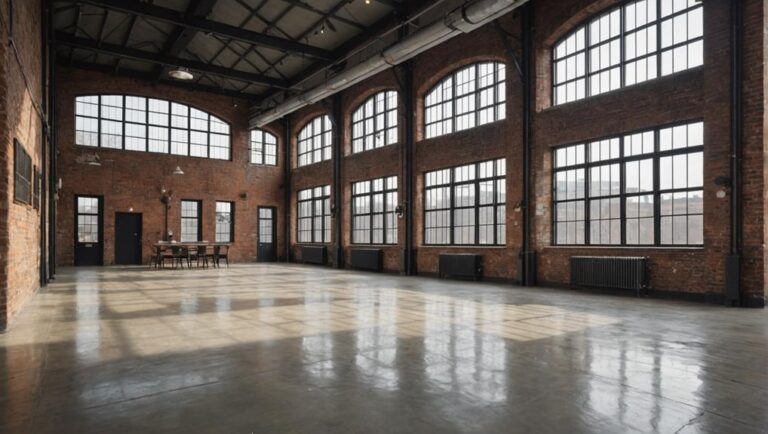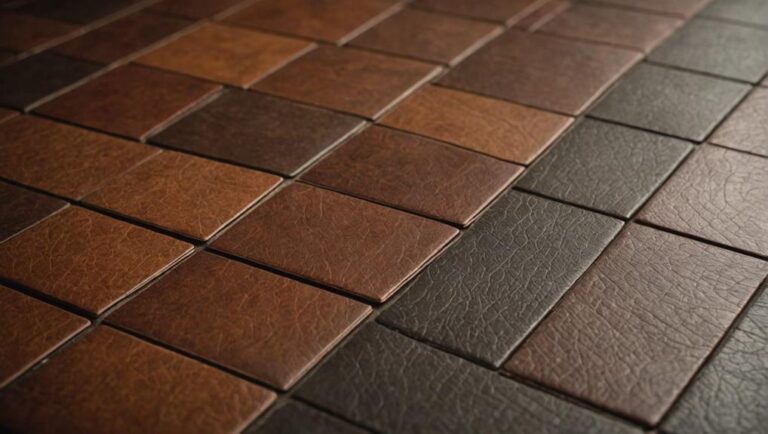To clean and maintain smart flooring systems, start with a daily routine of sweeping and vacuuming using soft-bristled tools to prevent scratches. Use pH-balanced eco-friendly cleaners with a damp microfiber mop, making sure you avoid excessive moisture. Deep clean periodically with specialized equipment and follow a structured approach, focusing on integrated features like sensors to guarantee their functionality. Regularly inspect for signs of wear and humidity levels to prevent damage. For peak performance, consider professional maintenance options to address issues effectively. There's more to explore regarding specific techniques and tools that will enhance your flooring's longevity and performance.
Understanding Smart Flooring Systems
Understanding smart flooring systems involves recognizing their unique components and functionalities. As you investigate these systems, you'll find they integrate advanced smart technology with various flooring materials to offer enhanced safety and performance. These systems often feature sensors embedded within the flooring, enabling real-time data collection on foot traffic, temperature, and even moisture levels. This information can be vital in preventing accidents and maintaining ideal indoor environments.
The choice of flooring materials plays a significant role in the effectiveness of smart flooring systems. Durable options such as vinyl, laminate, or engineered hardwood are commonly used due to their resilience and ease of maintenance. Each material has its own set of characteristics that affect the overall safety and functionality of the system. For instance, some materials may provide better slip resistance, which is essential for minimizing fall risks in high-traffic areas.
Additionally, smart flooring systems can be integrated with building management systems, allowing for seamless monitoring and control of environmental factors. This integration can enhance energy efficiency and contribute to a safer living or working environment by automatically adjusting lighting or temperature based on occupancy data.
As you explore smart flooring systems, understanding these components and their interactions will help you appreciate their potential benefits. Prioritizing safety through informed choices in materials and technology will guarantee you're making the best decisions for your space.
Essential Cleaning Supplies
Cleaning smart flooring systems requires a specific set of supplies designed to maintain their functionality and appearance without compromising the embedded technology. To achieve ideal results, you should invest in eco-friendly products that effectively clean without damaging sensitive sensors or electronic components. Look for pH-balanced cleaners specifically formulated for your flooring type, guaranteeing they're free from harsh chemicals that could impair the system's performance.
Incorporating advanced cleaning gadgets can also enhance your maintenance routine. For instance, a microfiber mop paired with a gentle cleaning solution can effectively trap dirt and debris without scratching the surface. When selecting cleaning gadgets, opt for those that are specifically labeled as safe for smart flooring systems, as traditional mops or abrasive scrubbers could potentially harm the flooring or its embedded technology.
To further guarantee safe and effective cleaning, consider using vacuum cleaners equipped with soft bristles or rubberized rollers designed for delicate surfaces. These gadgets help avoid scratches while removing debris efficiently. Additionally, steam cleaners can be beneficial, but only if they have a setting suitable for your flooring type, as excessive heat or moisture can damage electronic components.
Daily Cleaning Routine
To maintain the integrity of your smart flooring system, you should establish a daily cleaning routine. Start by sweeping regularly to remove dirt and debris, followed by employing a damp mop technique to prevent excess moisture accumulation. It's essential to avoid harsh chemicals that can damage the flooring finish, ensuring longevity and performance.
Sweep Regularly
Keeping your smart flooring systems in prime condition starts with a consistent sweeping routine. Regular sweeping is crucial to prevent dust accumulation, which can lead to scratches and wear over time. To guarantee effective cleaning, use appropriate sweeping techniques tailored to your flooring material.
Begin by choosing a soft-bristle broom or a microfiber dust mop, as these options are less likely to damage the surface. When sweeping, always work in a systematic pattern, starting from one corner and moving toward an exit. This approach helps to avoid missing spots and allows for the efficient collection of debris.
Don't forget to pay special attention to high-traffic areas where dirt and dust tend to accumulate more rapidly. For best results, sweep daily, especially in homes with pets or children, as they contribute considerably to dust buildup.
After sweeping, consider using a vacuum with a hard floor attachment for thoroughness, particularly if you notice larger particles that the broom might have missed. Maintaining this routine not only enhances the longevity of your smart flooring systems but also contributes to a cleaner, safer environment for you and your family.
Damp Mop Technique
Incorporating a damp mop technique into your daily cleaning routine is crucial for maintaining the appearance and integrity of your smart flooring systems. This method not only removes dirt and debris but also minimizes the risk of damaging your flooring. To begin, select a suitable mop type; microfiber mops are highly recommended due to their ability to trap dust without scratching surfaces.
For effective cleaning, mix a small amount of a floor-safe cleaning solution with water in a bucket. Make certain the mop is damp, not soaking wet, to prevent excessive moisture, which can lead to warping or other damage. It's important to mop in sections, allowing you to control the cleaning frequency and guarantee thorough coverage. Aim to damp mop high-traffic areas daily, while less frequented spaces can be attended to every few days.
After mopping, allow the flooring to air dry completely. This practice not only enhances safety by reducing slip hazards but also aids in preserving the long-term functionality of your smart flooring systems. By following this damp mop technique, you'll make sure your floors remain in peak condition.
Avoid Harsh Chemicals
Many homeowners underestimate the impact of harsh chemicals on smart flooring systems. These substances can degrade the materials over time, leading to discoloration, surface damage, and weakened structural integrity. To maintain the durability and appearance of your flooring, consider avoiding these harmful agents in your daily cleaning routine.
Instead, opt for eco-friendly alternatives that effectively clean without compromising safety. Vinegar and water solutions can be a great choice for regular maintenance, as they're both non-toxic and effective against dirt and grime. Additionally, using a microfiber mop can enhance dirt removal without the need for abrasive cleaners.
Chemical-free solutions, like baking soda and natural citrus-based cleaners, can also provide excellent results while being gentle on your smart flooring. Always verify that any product you choose is compatible with your flooring type to avoid any adverse reactions.
Deep Cleaning Techniques
To effectively deep clean your smart flooring system, you'll need the right tools and a systematic approach. Begin by gathering specialized equipment designed for your flooring type, as this guarantees ideal results without damage. Next, follow a step-by-step cleaning process to thoroughly address dirt and grime buildup.
Tools for Deep Cleaning
When it comes to maintaining the integrity and appearance of smart flooring systems, having the right tools for deep cleaning is crucial. Utilizing the appropriate vacuum types and adhering to a structured cleaning schedule can greatly impact the longevity and cleanliness of your flooring.
Here's a table to help you identify essential tools:
| Tool Type | Description |
|---|---|
| Vacuum Cleaner | Choose a model with HEPA filters to effectively trap dust and allergens. |
| Microfiber Mop | Ideal for capturing fine dust and preventing scratches. |
| Soft-Bristled Brush | Use for gently scrubbing stubborn stains without damaging the surface. |
| pH-Neutral Cleaner | Safe for smart flooring, it guarantees effective cleaning without harsh chemicals. |
| Floor Protector Pads | Place under furniture to prevent scratches during regular cleaning. |
Step-by-Step Cleaning Process
Having the right tools sets the foundation for an effective cleaning regimen, but understanding the step-by-step process for deep cleaning smart flooring systems is equally important. Start by removing loose debris using a soft-bristle broom or vacuum designed for smart flooring. This eliminates dirt that can scratch the surface during deeper cleaning.
Next, prepare a cleaning solution specifically formulated for your flooring type, verifying it's compatible with smart technology integration. Always refer to the manufacturer's guidelines for recommended products. Once your solution is ready, dampen a microfiber mop with it—avoid soaking to prevent moisture damage.
Begin mopping in sections, applying even pressure. This method verifies thorough cleaning while maximizing the smart flooring benefits, such as stain resistance and durability. After mopping, allow the floor to air dry completely to prevent slips and maintain the integrity of the smart technology.
Maintaining Integrated Features
Maintaining integrated features in smart flooring systems requires a meticulous approach to guarantee ideal performance and longevity. You need to pay particular attention to integrated sensors and verify that feature updates are regularly implemented. These sensors play a critical role in monitoring environmental conditions and preventing potential hazards, so their functionality must be preserved.
To facilitate maintenance, consider the following key aspects:
| Task | Frequency | Notes |
|---|---|---|
| Inspect integrated sensors | Monthly | Look for physical damage or misalignment. |
| Update system software | Quarterly | Verify the latest features and security patches are installed. |
| Clean sensor areas | Bi-monthly | Use a soft, damp cloth to avoid damaging sensitive components. |
| Test sensor functionality | Annually | Conduct a functional test to verify accuracy. |
| Review performance data | Semi-annually | Analyze data to identify any performance issues or required adjustments. |
In addition to these tasks, always refer to manufacturer guidelines for specific maintenance recommendations. Keeping your smart flooring systems updated and well-maintained not only enhances their longevity but also verifies that safety features remain effective. Regularly addressing integrated features will mitigate risks associated with sensor failure or outdated technology, providing you with peace of mind. By following these practices, you'll contribute to a safer environment and maximize the benefits of your smart flooring system.
Seasonal Maintenance Checklist
Conducting seasonal maintenance is essential for guaranteeing the continued performance and longevity of your smart flooring system. A well-executed seasonal checklist not only enhances the aesthetics of your flooring but also guarantees safety and functionality. Here's a concise checklist to help you with your spring cleaning and winter preparation:
- Inspect for Damage: Regularly check for any cracks, scratches, or signs of wear. Addressing these issues promptly helps maintain the integrity of your flooring.
- Deep Clean: During your spring cleaning, use a gentle cleaner specifically designed for your smart flooring material. Avoid harsh chemicals that could damage electronic components.
- Check Smart Features: Guarantee that all integrated smart features are functioning correctly. Update software and run diagnostic tests to confirm proper operation.
- Humidity Control: For winter preparation, monitor humidity levels in your home. Smart flooring systems can be sensitive to extreme changes in humidity, so using a humidifier or dehumidifier may be necessary.
Troubleshooting Common Issues
When you encounter issues with your smart flooring system, addressing them promptly is fundamental for maintaining ideal performance. Start by checking the user interface for any error messages that can indicate specific problems. If you notice connectivity issues, verify your Wi-Fi network is stable, as this can affect the system's functionality. Regular software updates are essential; outdated software can lead to performance lags or malfunctions.
Next, pay attention to sensor calibration. If your system's sensors aren't accurately detecting moisture levels or temperature fluctuations, recalibrating them may resolve inconsistencies. Follow the manufacturer's guidelines for proper calibration procedures to guarantee optimal functionality.
Moisture detection issues can lead to significant problems, such as mold growth. If your system detects abnormal moisture levels, investigate the source immediately. It's important to address any leaks or spills promptly. Additionally, surface scratches can affect the appearance and performance of your flooring. If you notice scratches, consider using a recommended repair kit, verifying that it's compatible with your flooring material.
Lastly, inspect the power supply. A faulty power connection can lead to intermittent functionality or complete system shutdowns. Confirm all connections are secure and that the power source is operational. By systematically addressing these common issues—sensor calibration, connectivity, temperature fluctuations, software updates, moisture detection, surface scratches, and power supply—you'll maintain the safety and efficiency of your smart flooring system, guaranteeing it continues to serve you well.
Professional Maintenance Options
For ideal performance and longevity of your smart flooring system, evaluating professional maintenance options is essential. Engaging experts guarantees that your flooring remains in prime condition, minimizing risks associated with improper care. Here are four key aspects to evaluate:
- Routine Inspections: Regular assessments by trained professionals can identify potential issues before they escalate. These inspections typically include checking for wear, functionality of smart features, and environmental conditions affecting your flooring.
- Service Contracts: Opting for a service contract can save you time and money. These contracts often include scheduled maintenance visits, guaranteeing that your flooring receives consistent attention and care.
- Specialized Cleaning: Professionals utilize specific cleaning methods and products tailored to your smart flooring's material. This guarantees that the integrity of your flooring is maintained while removing dirt and allergens effectively.
- Repairs and Upgrades: Should any part of your smart flooring system require repair or upgrade, professionals can perform these tasks efficiently and safely, guaranteeing compliance with manufacturer standards.
Engaging in professional maintenance not only enhances the lifespan of your flooring but also guarantees a safer, more efficient living environment. By prioritizing routine inspections and evaluating service contracts, you can enjoy peace of mind knowing that your investment is well-protected. Always choose certified professionals to handle your smart flooring to guarantee you meet safety standards and manufacturer recommendations.
Frequently Asked Questions
Can Smart Flooring Systems Be Installed Over Existing Flooring?
Yes, smart flooring systems can often be installed over existing flooring, but you need to take into account several installation considerations. Verify the existing flooring is compatible; it should be flat, stable, and free of moisture. Certain materials, like carpet, might not be suitable due to potential interference with the smart features. Always check manufacturer guidelines to confirm compatibility and maintain a safe installation process, guaranteeing peak performance and longevity of your new flooring system.
Are Smart Flooring Systems Suitable for Outdoor Use?
Smart flooring systems aren't typically designed for outdoor use due to concerns around smart flooring durability and outdoor weather resistance. While some materials may withstand mild conditions, prolonged exposure to harsh elements can compromise functionality and safety. You should always consider dedicated outdoor flooring solutions if you need a robust surface for exterior applications. Ensuring safety and longevity in outdoor settings often requires specialized products tailored for those specific environmental challenges.
What Warranty Options Are Available for Smart Flooring Systems?
When considering warranty options for smart flooring systems, you'll find various coverage plans depending on the manufacturer. Typically, warranty coverage can include defects in materials or workmanship for a specified period. It's crucial to review the installation details, as proper installation often impacts warranty validity. Confirm you keep documentation and follow the manufacturer's guidelines to maintain your warranty. This protects your investment and guarantees the flooring remains safe and functional over time.
How Do I Reset My Smart Flooring System?
To reset your smart flooring system, start by locating the reset button on the control panel. Press and hold it for about 10 seconds until you see a confirmation light. This can help resolve common issues and guarantee you're benefiting from all its features. If you're still having trouble, consult the troubleshooting tips in your user manual. Safety's key, so make sure the area is clear before you begin the reset process.
Can Pets Damage Smart Flooring Systems?
Yes, pets can damage smart flooring systems if their behavior isn't managed. Scratching, chewing, and accidents can compromise flooring durability. It's essential to train your pets, provide designated play areas, and use appropriate mats to minimize risks. Regular inspections for scratches or wear can help maintain the integrity of your flooring. By being proactive about your pet's behavior and taking preventive measures, you can guarantee your smart flooring system remains in good condition.




